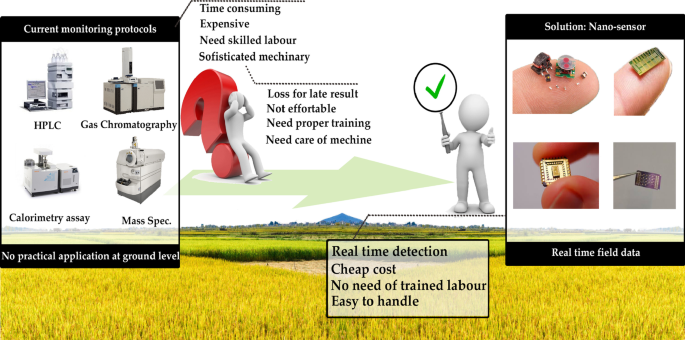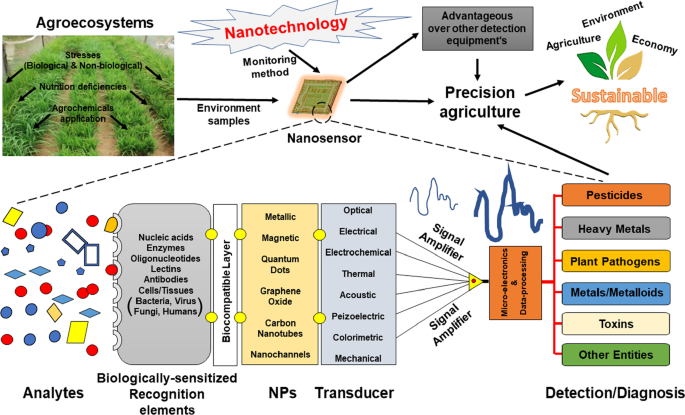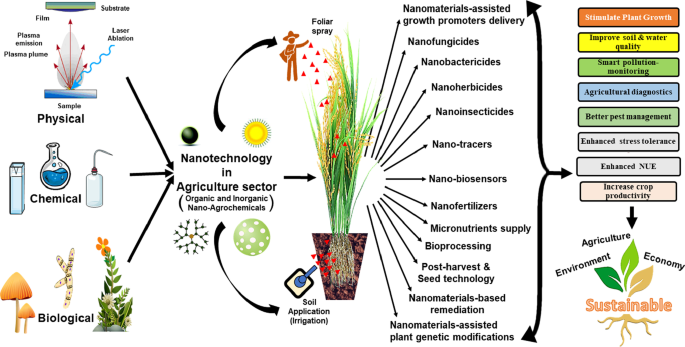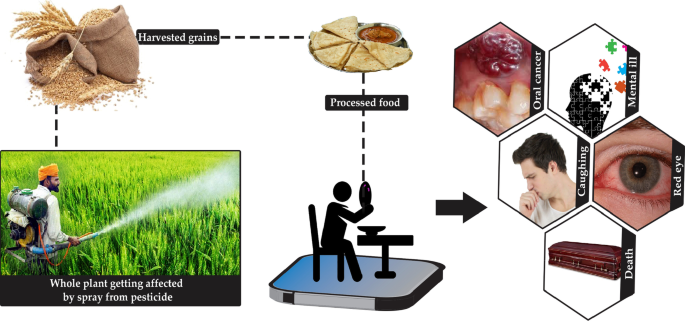農業生態系におけるバイオセンサーとナノセンサーの応用に関するレビュー
要約
過去数十年は、世界の食料安全保障を確保するという切実な必要性を引き起こした多くの課題を目の当たりにしてきました。食料生産を増強するプロセスにより、農業生態系は、さまざまな農薬の残留粒子の持続、重金属の蓄積、農業環境に悪影響を及ぼしている有毒な元素粒子による汚染など、多くの課題に直面しています。農産物を介した人体へのそのような有毒な要素の侵入は、神経および骨髄障害、代謝障害、不妊症、細胞レベルでの生物学的機能の破壊、呼吸器および免疫疾患などの多くの健康影響を引き起こします。農業生態系を監視するための緊急性は、残留農薬粒子の毒性作用による報告された年間22万人の死亡を考慮することによって理解することができます。農業生態系を監視するために採用されている現在の慣行は、ガスクロマトグラフィー、高速液体クロマトグラフィー、質量分析などの技術に依存しています。 複数の制約があり、費用がかかり、面倒なプロトコルで面倒であり、熟練した人員とともに洗練されたアプライアンスを必要とします。過去数十年はナノテクノロジーの科学の大きな拡大を目撃しており、この開発は、人間に無害であるという利点を備えた自然の農業生態系を汚染するさまざまなエンティティを検出するための、適度で迅速かつ経済的に実行可能なバイオおよびナノセンサーの開発を大幅に促進しました健康。ナノテクノロジーの成長は、いくつかの金属イオン、タンパク質、農薬から完全な微生物の検出に至るまで、いくつかの複合材料を検出するためのバイオセンサーとナノセンサーの急速な発展をもたらしました。したがって、本レビューでは、農業生態系の監視に使用されるさまざまなバイオセンサーとナノセンサーに焦点を当て、概念実証から商品化段階までの実装に影響を与える要因を明らかにしようとしています。
はじめに
過去数十年は、永続的な人口動態の緊張、絶え間なく変動する気候条件、資源の懸賞の高まりなど、多くの課題を目の当たりにしてきました。これらはすべて、甚大な脅威をもたらし、世界の食料安全保障を保証するための切実な必要性を引き起こしました。食糧要件を満たすための既存の農業慣行には、資源の管理されていない使用、洗練された機械、および農薬の増加した無差別な使用が含まれます。これらの慣行は、土壌、空気、水資源の大幅な劣化をもたらし、それによって農業環境の汚染レベルを明らかに上昇させ、それが人間/動物の健康に大きな影響を与えました。農薬使用による健康への影響の程度は、世界全体で毎年2,600万人が農薬中毒の犠牲者になり、年間約22万人が死亡しているという情報から推定できます[1]。さらに、残留農薬はその持続性により、長期間環境にとどまり、それによって土壌を汚染し、土壌の機能、生物多様性、および食品の安全性に関する懸念を引き起こします[2]。さらに、食物連鎖への残留農薬の侵入とそれに続く消費者の体内への残留農薬についての多くの報告がすでに利用可能であり、それはさらに深刻な健康問題を引き起こします。農薬は、本質的に細胞毒性および発がん性があることも知られています[3,4,5,6]。また、さまざまな神経障害や骨髄障害、不妊症、呼吸器疾患や免疫疾患を引き起こす可能性があります[7、8、9、10]。したがって、環境中の残留農薬の監視は不可欠な関心事になります。さらに、そのような残留農薬を定期的に監視することで、それらの発生が許容範囲内かそれ以上かについての情報も提供されます[11]。
農業生態系が直面するもう1つの重要な課題は、カドミウム、水銀、銅、亜鉛、ニッケル、鉛、クロムを含む致命的な重金属が持続することです。細胞レベル[12、13]、例えば、光合成の破壊、ミネラル吸収の破壊、電子伝達系の中断、脂質過酸化の誘導、必須元素の代謝の障害、酸化ストレスの誘導、および植物の損傷による根、葉、その他の細胞成分などの器官[14、15、16]。確かに、地殻でのそれらの自然発生は否定できない事実ですが、制御されていない人為的活動は、これらの元素の地球化学的循環と生化学的バランスを著しく乱しました。これは、さまざまな植物の部分でそのような金属の有病率の増加をもたらしました。同時に、さまざまな生態系における重金属の存在と蔓延によってもたらされるすべてのリスクは、環境サンプル中の低濃度でもそれらを感知するためのシステムを開発する必要性を強調しています[17]。
現在、農業生態系のモニタリングに利用できるさまざまな方法には、ガスクロマトグラフィー、高速液体クロマトグラフィー、質量分析などがあります(図1)。これらの技術はすべて、環境中の汚染物質や農業サンプルを簡単に検出して定量化することができます。それどころか、そのような測定の感度、特異性、および再現性は議論の余地がありませんが、これらの方法の展開は、時間の消費、高コスト、および熟練した人員と一緒に洗練された機器の要件によって主に制限されます[8]。したがって、そのような農業汚染物質を監視するための、控えめで、迅速で、経済的に実行可能な方法に対する不可解な必要性があります[18、19、20]。ナノセンサーは、特定の分子、生物学的成分、または環境環境を識別するように設計されたナノスケールの要素デバイスです。これらのセンサーは、非常に特異的で、便利で、費用効果が高く、マクロスケールのアナログと比較してはるかに低いレベルで検出されます。一般的なナノセンサーデバイスの操作には、次の3つの基本コンポーネントが含まれます。
- 1。
サンプル準備:それは、気体、液体、または固体の均質または複雑な懸濁液である可能性があります。農業生態系のサンプル準備は、不純物と干渉のために非常に困難です。サンプルには、センサーがターゲットにできる特定の分子、分子または生物の官能基が含まれています。分析物として知られるこれらの標的分子/生物は、分子(染料/色、毒物、農薬、ホルモン、抗生物質、ビタミンなど)、生体分子(酵素、DNA / RNA、アレルゲンなど)、イオン(金属、ハロゲン、界面活性剤など)、ガス/蒸気(酸素、二酸化炭素、揮発性化合物、水蒸気など)、生物(細菌、真菌、ウイルス)および環境(湿度、温度、光、pH、天候など)。 )
- 2。
認識:特定の分子/元素は、サンプル内の分析物を認識します。これらの認識分子は、抗体、アプタマー、化学的凡例酵素などであり、分析物に対して高い親和性、特異性、選択的特性を持ち、許容レベルまで定量化します。
- 3。
シグナル伝達:特定のシグナル伝達法では、これらの控えめなデバイスを、光学、電気化学、圧電、焦電、電子、重量測定のバイオセンサーなどのさまざまなタイプに分類しています。認識イベントを計算可能な信号に変換し、さらに処理してデータを生成します(図2)。

従来の監視技術と高度な監視技術の違いを強調する概略図

農業生態系を監視するためのナノセンサーのコンポーネントを示す簡略化された表現
ナノテクノロジーの介入は、健康、投薬、食品、環境、さらには農業部門などの診断の多様なゾーンを変容させる刺激を位置付け、それによって投機的な特徴を実際の成果に移行させます[21、22、23、24、 25、26、27、28]。ナノテクノロジーは、バイオテクニック、ナノベースの医療施設で確立されたセンサー、および農薬、残留薬物、食品の検出を簡素化するバイオフォトニクスで構成される現代的なツールで人類をレンダリングすることにより、多くの診断方法の進歩に重要な役割を果たします。媒介される病原性微生物、毒素汚染物質、および重金属イオン[24、29]。幸いなことに、ナノテクノロジーの分野は、物質が類似物質のバルク形態と同等である場合に独特の属性と性能を明らかにする、原子または分子スケールでの物質の支配と結びついた理解を備えています[30]。現在、すべてのアプローチの中で、バイオセンサーは、生物学的起源の認識コンポーネントを使用することにより、定量的な方法または半定量的な形式で明確な体系的なデータを生成する機能を備えた、控えめでコンパクトな調査デバイスです。信号変換ユニット[31、32、33]。シグナル伝達法の採用のタイプは、これらの控えめなデバイスを、光学、電気化学、圧電、焦電、電子、および重量分析バイオセンサーなどのさまざまなタイプに分類しました[34]。ナノテクノロジーの最近の進歩により、バイオセンサーを設計するためのさまざまな新しい方法が開かれました[29、35]。ナノ材料とさまざまなバイオセンシングデイズ(ナノバイオセンサー)とのハイブリダイゼーションは、検出の感度を高めるための多くの結合および多目的アプローチを提供し[36]、それによって単一分子のモニタリング能力を向上させます[32、37 、38]。ナノスケールは約1〜100 nmと定義されており、これも1メートルの10億分の1に相当します。直径約1000nmの平均的な細菌細胞の寸法と比較することで簡単に理解できます[39]。センシングに使用されるナノマテリアルはナノセンサーと呼ばれ、データ収集のために原子スケールで構築されます。ナノマテリアルはさらに情報に再割り当てされ、たとえば、接近が困難な領域のさまざまな物理的および化学的前兆を監視し、さまざまな細胞小器官で生物学的起源のさまざまな化学物質を検出し、ナノスケールの粒子を決定するために、いくつかのアプリケーションで分析できます。環境と産業において[40、41]。ナノセンサーを使用すると、単一のウイルス粒子や非常に低濃度で存在する物質の存在を検出できます。ナノセンサーは、トランスデューサーと呼ばれる別の要素に共有結合している生体感受性層で構成されています。標的分析物と生体受容体との相互作用によって生じる物理化学的変化は、電気信号に変換されます[40]。
近年、膨大な数のサンプルからいくつかの複合材料を検出するために、非常に優れた視覚認識バイオセンサーとナノセンサーが採用されています。複合材料の範囲は、いくつかの金属イオン、タンパク質、農薬、完全な微生物の検出のための抗生物質、および核酸の増幅と配列決定をカバーしています[19、33、42、43]。農業管理プロセスと残留物の監視とは別に、ナノテクノロジーの他の潜在的な用途も過去20年間に表面化しています[44、45、46、47]。農業部門の改善にナノテクノロジーを関与させるための必須の利点には、成長促進剤のナノ材料支援送達[44、48、49]、栄養(特に微量栄養素)[49、50]、および植物の遺伝子組み換え[51、52 ]。さらに、ナノ殺菌剤、ナノバクテリア殺虫剤、およびナノ殺虫剤の形のさまざまな農薬も使用されていることがわかっています[50、53、54、55]。さらに、ナノテクノロジーの他の利点には、ナノマテリアルベースの修復[56]、ナノ除草剤[57]、およびバイオプロセシング[58]、水産養殖[59]、収穫後技術[60]、獣医ケア[61]、漁業[ 62]、およびシードテクノロジー[63]。これらすべてのアプリケーションは、汚染の削減(主に土壌と水)、環境保護の関連コストの削減、栄養素の使用効率の向上など、さまざまな利点を一緒に示します[45、46、50、56、64、65、66、67、68](図3)。上記の事実を踏まえ、今回のレビューでは、さまざまな農業生態系にさまざまな種類のナノセンサーを使用して、さまざまな成分を明らかにし、自然の農業生態系に侵入するいくつかの異物を検出することを目標としています。

農業分野におけるナノテクノロジーのさまざまな応用
農薬検出用のナノセンサー
農薬は、農業生態系の生産性を高めるために、害虫、昆虫、雑草、菌類を回避、規制、または廃止するための農業システムでの幅広い用途があります[69]。農薬の使用は絶えず増加しており、世界の農産物のほぼ3分の1のシェアを確保する可能性があります[70]。しかし、野外での農薬の無差別使用は地下水を汚染し、それらが食料資源に蓄積することを示し、それによって人間や動物などの非対象種にも深刻な影響を及ぼしました(図4)。農薬へのヒトの曝露はさまざまな方法で健康に影響を与える可能性があり、それに伴う健康への影響は、変異原性、神経毒性、発がん性から遺伝子毒性にまで及ぶ可能性があります[71、72]。有機リン酸塩のようないくつかの農薬は、低濃度での使用や高濃度への暴露でも動物の体内に蓄積し、アセチルコリンエステラーゼのような酵素の阻害につながり、人間に深刻な健康上のリスクを与えます[73]。したがって、食品の安全性を確保するためには、残留農薬を検出する優れた方法の開発が非常に重要です。

農薬が人間の健康に及ぼす悪影響
高速液体クロマトグラフィー、比色分析、酵素結合免疫吸着分析、液体/ガスクロマトグラフィー-質量分析、電気泳動、および蛍光分析手順など、農薬残留物の検出には非常に長い間さまざまなアプローチが使用されてきました[8 、74、75、76、77、78、79]。それにもかかわらず、これらの技術の大部分は、高価な装置、専門のオペレーター、およびサンプルの複雑な前処理を必要とする単一信号アッセイであり、環境条件の変動を起こしやすいものもあります[80、81]。したがって、このような検出手段は、残留農薬の現場での検出には適していません。さらに、それらはまた、緊急の場合にそれらの使用を制約するリアルタイム検出に適切であることが見出されていない[82]。その結果、複数の信号を使用する検出方法により、分析の信頼性と利便性が向上します。たとえば、多信号蛍光法と比色分析の組み合わせを対象とする方法は、多面的な構造におけるバックグラウンドの影響を回避し、さまざまな実際の勧誘における肉眼センシングを補完することができます[83]。したがって、迅速、単純、選択的、繊細、正確、かつ理解可能な手段で農薬を検出するためのさまざまなアプローチを評価することにさらに力を注ぐことで、残留農薬を検出するための光学センサーの開発につながりました[80]。
酵素、抗体、分子インプリントポリマー、アプタマー、ホスト-ゲスト認識装置などの認識要素を利用した農薬検出では、すでに多くの光学戦略が認識されています。このようなアプローチは、特定の殺虫性粒子をしっかりと認識して検出することができます[81、84、85、86、87、88]。さらに、認識コンポーネントとナノマテリアルの結合により、迅速かつ効果的な農薬検出の主要な要件である、より高いレベルの感度と瞬時の展開に対する途方もない特異性がもたらされます[82]。したがって、残留農薬を検出するための迅速で、感度が高く、具体的で、正確で、操作が簡単な方法の探求は、費用効果、コンパクトさ、輸送の容易さのために、従来の方法の卓越した代替品としてナノセンサーの展開をもたらしました。並外れた感度と検出時間の短縮[89](図1)。
一般に、光学センサーは、特定の残留農薬粒子に固有の認識要素で構成され、他の構成要素であるトランスデューサーとネットワークを構築できます。トランスデューサーは、特定の残留農薬をセンサーに結合するための信号を生成するために使用されます。 。酵素、抗体、分子インプリントポリマー、アプタマー、およびホスト-ゲスト認識機能で構成される認識コンポーネントは、センサーの診断パフォーマンスを向上させるために科学界の考慮を集めています。普及している定着した光プローブは、信号出力フォーマットに基づいて4つのタイプに分類できます。これらは、蛍光(FL)、比色(CL)、表面増強ラマン散乱(SERS)、および表面プラズモン共鳴(SPR)光学センサーです[90]。
広く知られている別の種類のナノセンサーは、ポイントオブケア分析装置で広く認定されている免疫クロマトグラフィーストリップ(ICTS)ナノセンサーです[91]。免疫クロマトグラフィーアッセイは、ポイントオブケア検査の動作により、農業生態系のモニタリングに関与していることも報告されています。たとえば、GM作物を検出するために報告された免疫クロマトグラフィーアッセイでは、目に見える比色読み取り戦略が採用されました。これは、はい/いいえの応答しか提供せず、感度が不十分であることがよくありました[92,93,94]。同様に、金ナノ粒子ベースのICTSセンサーも、比較的弱い色濃度の生成により、検出感度が低く、その用途が制限されることが報告されています[95、96]。ただし、検出信号強度の増強、試薬の親和性の強化、ラベリング技術の最適化、ストリップデバイスの形状の修正など、いくつかの提案された増幅戦略によって感度を向上させることができます[96]。したがって、改良されたICTSナノセンサーは、農業生態系における残留農薬検出のための経済的に実行可能なツールであることが証明することもできます。
さまざまな電気化学的アプローチによるナノテクノロジーの融合は、電極の微小環境の適切なチェックとともに、センサーに対する優れた操作表面積を損ないます。ナノ粒子は発散し、多くの特性を備えているため、電気化学現象に基づくセンシング構造で複数の目的を果たす可能性があります。たとえば、電気化学反応の触媒、電子の移動の強化、タグ付け、反応物としての実行などです[97]。したがって、電気化学的ナノセンサーは、農薬の検出を目的とした効果的なツールであるように思われます。最近、主に酵素コリンエステラーゼに基づいた電気化学的バイオセンサーが、特にカルバメートおよび有機リン酸塩のクラスに属する残留殺虫性粒子を検出するための適切な装置として登場しました。それにもかかわらず、酵素ベースのバイオセンサーは、高価格、酵素の活性の低下、再現性の低下など、非常に多くの制限を受けます[100]。さらに、酵素は本質的に不安定であるように思われ、また、バイオセンサーの寿命を制限し、それによってそれらの実際の用途を制限する、敵対的な環境条件での変性を受けやすい[101]。さらに、生物学的起源のサンプルでのさまざまな重金属の発生など、いくつかの不純物の発現も、検出中の酵素の選択性と感度を乱し、偽陽性の結果をもたらす可能性があります[102]。したがって、それは非酵素的電気化学バイオセンサーの必要性を引き起こします。ナノマテリアルは、非酵素的電気化学センサーを策定するための有望な競争相手であるように思われます[103]。ナノ粒子を構成するさまざまなカテゴリのナノ材料(例:CuO、CuO–TiO 2 、およびZrO 2 、NiO)、ナノコンポジット(モリブデンナノコンポジットなど)、およびナノチューブ(ペプチドやカーボンナノチューブなど)は、残留農薬粒子の電気化学的な測定に関与していることが広く知られています[104、105、106]。そのようなナノ材料による残留殺虫性粒子の明確で深遠な調査は、それらの非常に小さいサイズ、より大きな表面積、および比類のない電気的および化学的特性の保有に起因します[70]。
明確な農薬に対するさまざまなナノセンサーの感度と選択性は、さまざまな研究で報告されています(表1)。たとえば、銀ナノデンドライトとアップコンバートナノ粒子に基づく2つの異なる光学センサーは、農薬のジメトエートとメトリブジンを検出することがわかりました。 0.002ppmおよび6.8×10 -8 のレベル それぞれM [107、108]。同様に、3Dグラフェンナノコンポジットで装飾されたCuOナノ粒子を使用して接地された電気化学ナノセンサーは、0.01 nMのレベルでマラチオンを検出しました[109]が、キトサン-酸化鉄ナノコンポジットを介して製造された電気化学アプタセンサーは、0.001 ng / mLの驚くべき感度でマラチオンを検出しました[110]。 。
<図>重金属を検出するためのナノセンサー
Pb 2+ のような多様な重金属イオンの存在 、Hg 2+ 、Ag + 、Cd 2+ 、およびCu 2+ さまざまな資源からの人々は、人間とその周囲に不安定な影響を及ぼします。さまざまな環境での重金属の蓄積は、廃水からの重金属イオンの不十分な排出と家庭からの排出に加えて、農業と産業の成果の途切れない増加によって支えられています[111]。したがって、健康分析とともに環境の安全を確保するために、熟練した慣行による微量の重金属イオンのフェレットアウトが非常に望まれています。重金属の把握は、いくつかの分析システム[112]、たとえば、蛍光X線分析(XRF)、原子吸収分光法(AAS)、原子発光分析(AES)、および誘導結合プラズマ質量分析( ICP-MS)ですが、それらのアプリケーションには、デバイスの豪華さ、時間のかかる方法、労働集約度など、多くの制限があります。したがって、これらの制限を導くために、多くの種類の光学的、電気化学的、および比色戦略が包括的に精査され(表2)、重金属イオンの繊細で、急いで、識別力のある探査を捕らえるための控えめで儲かるデイズを考案しました[113、114]。
<図>重金属検出の対象となることが多い光学化学センサーは、変換要素として知られる要素で診断信号を生成するために主に電磁放射を使用する化学センサーのクラスターに適合します。サンプルと放射線の間の相互作用は、分析物の濃度に相互に関連する可能性のある特定の光学的考慮事項を変更します[115、116]。たとえば、カドミウムを検出するためにナノハイブリッドCdSe量子ドットを使用して合成された光学ナノセンサーは、カドミウム金属の感覚で緑色のフォトルミネッセンスを回復しました[117]。光学化学センサーは、停止したインジケーター(有機色素)と分析物の結合の結果として現れる光学的所有物(発光、吸収、透過、寿命など)の見かけの変化の原理に基づいて機能します[118]。グラフェンベースのナノテクノロジーを誘惑するアプローチは、そのような課題を無力化し、強化されたパフォーマンスでセンシングプラットフォームを遺贈する帰属ツールとして着手します。グラフェン由来のナノ材料に主に基づいた光学技術は、それらの柔和な構造の可能性のある卓越性といくつかの特徴的な金属イオンの知覚的評価のために、重金属イオンを検出するための刺激的な慣行の1つとして最近進歩しました[116]。 / P>
Ag、Au、Pdのような高貴なナノ粒子は、ペルオキシダーゼ活性を模倣するという独特の特性を備えており、グラフェンとの凝集により、優れた触媒性能とともに堅牢性が向上します。この機能に基づく多数の重金属イオンの検出に関係するセンサーには、さまざまな規模があります。酸化グラフェンと銀ナノ粒子のハイブリダイゼーションにより、ペルオキシダーゼ酵素活性を模倣したナノハイブリッドが得られ、さらに、二本鎖および一本鎖DNA分子の中で識別できることがわかりました。したがって、Pb 2+ の熱量測定検出を行います およびHg 2+ DNAコンフォメーションの金属イオンによる変化に基づいて適切です。これは、コンフォメーションが発生時に四重配列またはヘアピンのようなアセンブリに変更されたためです[119、120]。さらに、そのような比色アプローチは、それらの単純な操作、経済的に実現可能で、輸送可能な計装、および使いやすい用途のために有利である。重金属を検出するための化学センサーは、二次汚染を引き起こすため、目的の種を排除するのに厄介であることがわかっています。したがって、単一のナノコンポジット粒子に蛍光機能と磁気機能を統合することは、有能な代替手段のようです[121]。それにもかかわらず、磁性ナノ粒子の発現は、蛍光部分のフォトルミネッセンスを強力にクエンチし、したがって、そのような種類のナノコンポジットの開発に向けて着実な挑戦を上る。したがって、この懸念を回避するために、疎水性および静電相互作用、水素結合、共有結合など、分子レベルで発生する多数の相互作用がナノコンポジット合成の対象となることがよくあります。たとえば、ポリマー層状のFe 2 の浅いところに配置された量子ドット O 3 チオール化学のアプローチを採用することによる小球。 Fe 2 を含むいくつかの材料の表面で逮捕された金ナノ粒子 O 3 ナノ粒子、および静電接続を採用したシリカミクロスフェアも合成されています[122、123]。
ナノ化学の原理を使用してマルチモーダルナノセンサーを合成するアプローチは、水性媒体中の重金属イオンを効率的に検出するだけでなく除去するため、かなり魅力的です。 Satapathiらによって合成されたマルチモーダルナノセンサー。 [124]多段階の製造方法により、磁性体(Fe 2 )をカプセル化した薄いシリカシェルが必要になりました。 O 3 )ナノ粒子、不動のスペーサーアーム、およびスポットされた水銀イオンの同時認識と除去を目的とした蛍光量子ドット。このナノセンサーの並外れた感度は、Hg 2+ を検出する能力によって特徴づけられます。 ナノモルレベルで、検出限界はわずか1nmです。ナノセンサーの環境にやさしい側面は、外部の棒磁石を使用して検出された分析物を除去し、それによって汚染物質としての残留物を残さないという独自の属性によって提唱することができます。ナノセンサーの属性を改善するために、クエン酸多糖類、さまざまなポリマー、タンパク質など、いくつかの化合物がナノセンサーの安定化に使用されます[125]。エピカテキンで安定化された銀ナノ粒子は、Pb 2+ の識別検出に使用できます。 、それも、さまざまなスヌーピング金属イオンの発生で。検出下限、簡単な合成、見事な識別、および経済的な生産により、ECAgNPは、Pb 2+ の繰り返しチェックを目的とした強力なセンサーになります。 生態学的モデルの強度[126]。量子ドットの採用は、それらの光物理的および化学的属性の点で顕著な利点を提供し、それにより、蛍光量子ドットベースのセンサーを多数の金属イオンを感知するための効率的なツールにします[127、128]。しかし、量子ドットを採用することの主な欠点は、実際のアプリケーションでの量子ドットの分離と回復であり、これはたまたま不当で面倒で退屈な作業です。それにもかかわらず、磁性ナノ材料(Fe 3 O 4 )量子ドットベースの蛍光センサーにこの問題を解決し、比表面積が大きく、特殊な磁気特性、磁気操作性、および毒性が低いため、いくつかの追加の利点があります。ヤンら。 [128] Hg 2+ を検出および分離できる蛍光量子ドットおよび磁性ナノ材料と融合したカルボキシメチルキトサンに基づいた多機能磁気蛍光ナノ粒子を確立 同時に9.1×10 -8 の検知レベル mol / L。このように、ナノテクノロジーの気取らない洗練された方法論は、将来のフィールドベースの重金属感覚デバイスに関する方向性を提供します。これは現在、さまざまな制限とともに困難な作業であるように見えます。
Nanosensors for Detecting Plant Pathogens
The ascertainment, recognition, and assessment of pathogens are vital for scientific elucidation, ecological surveillance, and governing food security. It is imperative for investigative outfits that the delicate element of biological origin, which is a constituent of biological provenance or biomimetic constituent, interacts with the analyte in the examination. There are numerous profound, trustworthy, and swift recognition components, for instance, lectin, phage, aptamers, antibody, bacterial imprint, or cell receptor, which have been described for exposure of bacteria [129]. The most widely used biosensing components for analyzing pathogens are bacterial receptors, antibodies, and lectins. These constituents find wide applications as biosensing components to scrutinize pathogens owing to their adaptability of amalgamation into biosensors [130, 131]. Aptamers, the nucleic acids having only a single strand, are economically feasible and chemically steady, as compared to the recognition elements which are based on the antibodies for detecting bacteria [132]. However, they also pose various disadvantages like batch-to-batch variations, sturdiness in complex materials and they are also comparatively complex to prepare. The approach pointing to ‘chemical nose’ is a recently established equipment for detecting pathogens. It appoints multifarious discriminatory receptors that generate a unique response configuration for every objective, thus permitting their ordering. It functions in a fashion analogous to the working of our intellect of smelling something [133]. This technique involves the training of sensors with competent bacterial samples to establish a reference database. The identification of bacterial pathogens is done by equating them with the reference catalog [134]. Usually, nanoparticle-centered “chemical nose” biosensors necessitate the amendment of the surface of the nanoparticle with several ligands where an individual ligand is liable for a distinctive communication with the objective [133]. The variance in the size, as well as the external make-up of the nanoparticles, is selected in a way that every single set of particles can retort to different classes of bacteria in an inimitable way thereby offers supplementary features to the absorption spectrum.
The addition of nanoparticles to the bacteria leads to the development of aggregates encompassing the bacteria as a result of electrostatic interfaces amid the anionic sections of the bacterial cell walls and cationic cetyltrimethylammonium bromide (CTBr). This process of aggregation promotes a change of color induced by a swing in localized surface plasmon resonance. The color variation is further denoted by procuring an absorption spectrum in the existence of several bacteria [135, 136]. The components of the bacterial cell wall which are responsible for this kind of aggregation are teichoic acids in Gram-positive and lipopolysaccharides and phospholipids in Gram-negative bacteria [137]. These aggregation patterns are unique and are motivated by the occurrence of extracellular polymeric substances on the bacterial surface. These varying aggregation patterns are accountable for offering discernable colorimetric responses. Therefore the “chemical nose” established on nanoparticles could be accomplished to sense blends of varying bacterial species. During infections the “chemical nose” is potent enough to differentiate amid polymicrobial and monomicrobial cases, which facilitates superior effectiveness along with prompting antimicrobial therapy, precluding the requirement of extensive and prolonged testing of the sample [133]. The multichannel nanosensors are highly sensitive and can detect bacterial species even strains present in biofilms within minutes. Li etal。 [138] established a multichannel sensor based on gold nanoparticles (AuNPs) and used it to spot and recognize biofilms based on their physicochemical attributes. The sensitivity of the nanosensor can be well advocated by its ability to discriminate amongst six biofilms. Another sensor which was designed based on hydrophobically employed gold nanoparticles by Phillips et al. [139] rapidly recognized three different strains of E. coli 。 The conjugated polymers bearing negative charge in the sensor systems were eventually replaced by the pathogenic cells which differentially restored the polymer fluorescence.
Nanotechnology offers novel prospects for redefining the constraints of human discernment. In the course of evolution, the olfactory system of human beings has got the unique ability to detect volatile organic compounds present at tremendously low concentrations in different complex environments [140]. The great sensitivity and flexibility of human beings to differentiate more than a trillion olfactory stimuli marks olfaction as an encouraging dais for different biotechnological applications [141, 142]. Various effective sensors that primarily function based on olfaction have been proposed for unveiling bacteria. The system of such nanosensors is mainly encompassed of three different constituents:1) surface-functionalized nanoparticles, 2) pro-smell fragments, and 3) enzymes that slice the pro-fragrances for generating the olfactory output. The fine-tuning of these three components offer a delicate sensory system, which allows the rapid detection of bacteria at levels as low as 10 2 CFU/ML [143]. The introduction of magnetic nanoparticles also enables the separation, purification, and recognition of pathogens under complex environments. The nanomaterial-grounded, ‘enzyme nose’ nanosensor is also a convenient investigative method meant for detecting toxicologically significant targets present in natural samples. Sun et al. [134]designed a unique enzyme nanosensor, which was grounded on the non-covalent centers, for detecting pathogens. The employment of magnetic nanoparticles–urease sensors permitted the profound recognition of bacteria with a precision of 90.7% at the concentration of 10 2 CFU/LL in a very small time of 30 min. Similarly, various other different types of optical, electrochemical, and immunosensors have also been developed for detecting diverse plant pathogenic microorganisms (Table 3). For instance, the optic particle plasmon resonance immunosensor synthesized using gold nanorods effectively detected Cymbidium mosaic virus (CymMV) or Odontoglossum ringspot virus at the concentrations of 48 and 42 pg/mL (Lin et al. 2014) whereas the Fe3 O 4 / SiO 2 based immunosensor revealed the presence of Tomato ringspot virus , Bean pod mottle virus and Arabis mosaic virus at the concentrations of 10 −4 mg/mL [144]. Therefore, directing the performance of approachable nanomaterials at the molecular scale can be exploited to revise the annotations of humans regarding their environments in a fashion that seems otherwise unmanageable.
<図>Nanosensors for Detection of Other Entities
Amino acids are very crucial molecules required by the living systems as they play a pivotal role of building blocks in the process of protein synthesis [145], vital character for maintenance of redox environments in the cell and extenuating destruction from the toxin and free radicals [146]. The investigative methods for detecting amino acids have been reported, especially by chromatography, chemiluminescence, and electrochemistry [147]. However, the application of existing technologies is greatly restricted by the great expenses and time-consuming steps. Currently, nanomolecular sensors have been established for detecting such molecules owing to their chemical steadiness, bio-compatibility, and easy surface alteration [148, 149]. The employment of gold nanoparticles for biosensing solicitations has been reported in different biological environments. The amine side chain and sulfhydryl (thiol) group of amino acids may perhaps covalently bind with the gold nanoparticles, thereby inducing an accretion of these nanostructures which further results in a color alteration from red to blue on the aggregation of amino thiol molecules [150, 151]. Chaicham et al. [147] developed an optical nanosensor grounded on gold nanoparticles that could detect Cys and Lys at concentrations of 5.88 μM and 16.14 μM, respectively, along with an adequate percentage retrieval of 101–106 in actual samples.
Similarly, other metal ions that are required by living organisms for performing various metabolic functions can be detected by employing different nanosensors. A dual-emission fluorescent probe was developed by Lu et al. [152] for detecting Cu 2+ ions by condensing hydrophobic carbon dots in micelles molded by the auto-assemblage of different amphiphilic polymers. A vigorous, self-accelerating, and magnetic electrochemiluminescence nanosensor which was established on the multi-functionalized CoFe2 O 4 MNPs was established for the foremost and later employed for the extremely sensitive as well as discriminating recognition of the target Cu 2+ through click reaction in a quasi-homogeneous system [82]. Gold nanorods are also exploited for sensing Fe (III) ions. Thatai et al. [17] devised highly sensitive gold nanorods using cetyltrimethylammonium bromide as illustrative material for detecting ferric ions along with a surprising sensing level equivalent to 100 ppb. Zinc is another important element, and it occurs in a divalent cationic form as Zn 2+ イオン。 Zn 2+ ion has the capability of sustaining important activities counting synthesis of DNA and protein, RNA transcription, cell apoptosis, and metalloenzyme regulation [153, 154]. Usually, fluorescent probes are exploited for detecting the Zn 2+ ions in biological systems. The pyridoxal-5′-phosphate (PLP) conjugated lysozyme cocooned gold nanoclusters (Lyso-AuNCs) can also be exploited for the selective and turn-on detection of divalent Zn 2+ ions in the liquid environment. The yellow fluorescence of PLP Lyso-AuNCs displays noteworthy augmentation at 475 nm in the occurrence of Zn 2+ generating bluish-green fluorescence which is accredited to the complexation-induced accretion of nanoclusters. The developed nanoprobe can detect Zn 2+ ions in nanomolar concentrations (39.2 nM) [154]. The dual-emission carbon dots (DCDs) synthesized by Wang et al. [155] can also be exploited for revealing Zn 2+ ions as well as iron ions (Fe 3+ ) in different pH environments. The ferric ions could also be detected in an acidic environment along with an amazing sensation level equaling 0.8 µmol/L while Zn 2+ ions could be detected in an alkaline environment along with a detection limit of 1.2 µmol/L.
These days groundwater is used for irrigation and it is also the solitary seedbed of potable water in numerous regions, exclusively in the isolated agronomic sections. The capricious expulsion of numerous contaminants into the environment has expressively deteriorated the eminence of groundwater, thus has significantly threatened environmental safety [156, 157]. Although there are numerous micropollutants, however, the rushing of fluoride in groundwater has stretched out accumulative civic consideration as a result of the grave fluorosis, severe abdominal and renal complications persuaded by the elevated intake of fluoride ion [158]. So, there is a quest to diagnose and unveil hardness as well as the presence of fluoride ions in the ground-water which has expected substantial considerations owing to their significant parts in the different ecological, biological, and chemical processes [157]. Although fluorescent probes which are considered as traditional methods, can be exploited for detecting F − , however, the employment of quantum dots, an inorganic nanomaterial, can grab extensive considerations on account of their distinctive optical possessions comprising size-oriented fluorescence, tapered and coherent emission peak with a wide exciting wavelength, and outstanding photo solidity [159, 160]. The creation of a fluorescence resonance energy transmission channel from the carbon dots and the gold nanoparticles appears to be a competent solution for detecting numerous analytes. Therefore, constructing a novel nanosensor via gold nanoparticles and carbon dots for detecting F − seems to be a proficient strategy. The hybrid nanosensor assorted with calcium ions has been reported to spot fluoride ions along with a subordinate recognition level parallel to 0.339 ppm [103]. Lu etal。 [161] also developed another novel strategy for detecting fluoride, which was grounded on dual ligands coated with perovskite quantum dots, and the recognition level was found to be 3.2 μM.
The agricultural systems also necessitate the diagnosis of various other entities for the smooth functioning and enhanced productivity of the agroecosystems. The detection of other miscellaneous entities has also been facilitated by the employment of nanosensors (Table 3), for instance, the detection of transgenic plants, the presence of aflatoxins, and even the occurrence of wounds in plants. The SPR nanosensor developed using gold nanoparticles detected the Aflatoxin B1 at the concentration of 1.04 pg mL −1 [162] whereas the SERS-barcoded nanosensor fabricated using the encapsulation of gold nanoparticles with silica followed by the conjugation of oligonucleotide strands effectively detected the presence of Bacillus thuringiensis (Bt) gene-encoded insecticidal proteins in rice plants at 0.1 pg/mL, thereby, clearly advocating the transgenic nature of rice plants [163].
Nanosensors for Detection of Nanoparticles
Nanomaterials can also occur naturally, such as humic acids and clay minerals; extensive human activities can also lead to the incidental synthesis of various nanomaterials in the environment, for instance, diesel oil emanations or by the discharge of welding fumes; or they can also be explicitly concocted to unveil matchless electrical, optical, chemical or physical features [164]. These characteristics are exploited in plenty of consumable merchandise, for instance, medicines, food, cosmetics and suntan lotions, paints, and electronics, as well as processes that directly discharge nanomaterials into the surroundings, such as remediating contaminated environs [165, 166]. Furthermore, the rapid employment of metal nanoparticles in various systems has raised many concerns due to the potential environmental risks posed by them as they are unavoidably lost in the environment throughout the processes meant for their fabrication, conveyance, usage, and dumping [167]. Carbon-based nanomaterials are quite established against degradation and as a result, amass in the surroundings [168]. Nanoparticles, attributable to their greater surface area, find it much easier to bind and adsorb on the cellular surfaces. They harm the cell in several ways, such as, by hindering the protein transport pathway on the membrane, by destroying the permeability of the cell membrane, or by further inhibiting core components of the cell [169]. Currently, an overwhelming figure of the engineered nanoparticles engaged for different ecological and industrial solicitations or molded as by-products of different human deeds are ultimately discharged into soil systems. The usual nanoparticles employed comprise the metal engineered nanoparticles (elemental Fe, Au, Ag, etc.), metal oxides (SiO2 , ZnO, FeO2 , TiO2 , CuO, Al2 O 3 , etc.), composite compounds (Co–Zn–Fe oxide), fullerenes (grouping Buckminster fullerenes, nanocones, carbon nanotubes, etc.), quantum dots frequently encrusted with a polymer and other organic polymers (Dinesh et al. 2012). Different plant growth-promoting rhizobacteria (PGPR) like Bacillus subtilis , Pseudomonas aeruginosa , P. fluorescens, and P. putida , and different bacteria involved in soil nitrogen transformations are inhibited to varying degrees on exposure to nanoparticles in aqueous suspensions or pure culture conditions [170]. The nanoparticles grounded on metals copper and iron are alleged to interact with the peroxides existing in the environs thereby engender free radicals that are notorious for their high toxicity to microbes [171]. Therefore, there is a strong need to monitor the different nanoparticles which find an ultimate sink in the soils especially of agroecosystems.
Various techniques can be reconnoitered for sensing nanoparticles, one among them is the usage of microcavity sensors, which, in the form of whispering gallery resonators have acknowledged extensive consideration. Here, the particle binding on the exterior of the microcavity disturbs the optical possessions thereby instigating a resonant wavelength swing with magnitude reliant upon the polarizability of the particle. The measure of the change facilitates surveillance of the binding actions in real-time and is also used to evaluate the particle size [172]. Optical sensing empowered with the extreme sensitivity of single nanoscale entities is sturdily anticipated for solicitations in numerous arenas, for instance, in environmental checking, other than in homeland security. Split-mode microcavity Raman lasers are also highly sensitive optical sensors that can perceive the occurrence of even a single nanoparticle. The presence of nanoparticles is revealed by observing the distinct alterations in the beat frequency of the Raman lasers and the sensing level has been reported to be 20 nm radius of the nanoparticles [138].
Nanotechnology Implementation in an Agroecosystem:Proof-of-Concept to Commercialization
There are hundreds of research articles and studies that are being published every year on nanosensor's application in agriculture. However, very few nanosensors have yet been commercialized for the detection of heavy metals, pesticides, plant-pathogen, and other substances in an agroecosystem. Because these academic outputs are not properly converted/conveyed to commercial or other regulatory platforms. Certain scientific and non-scientific factors hinder these nanosensors from proof-of-concept to fully commercialized products. These factors are scale-up and real-use (technical), validation and compliances (regulatory), management priorities and decisions (political), standardization (legal), cost, demand and IPR protection (economic), safety and security (environmental health and safety) along with several ethical issues. It is necessary to support enthusiastic researchers and institutions for research and development to develop such nanosensors for agroecosystem, product validation, intellectual protection, and their social understanding and implementation. If we consider these factors strategically, it will help in nanosensor product betterment and implementation to agroecosystem. The US-based startup Razzberry developed portable chemical nanosensors to trace real-time chemical changes in water, soil, and the environment. Similarly, Italian startup Nasys invented a metal oxides-based nanosensor to detect air pollution. There are some other startups nGageIT and Tracense, implementing nanosensor technologies to detect biological and Hazardous contaminants in agriculture.
Perspectives and Conclusions
Since times immemorial, agriculture is the main source of food, income as well as employment for mankind around the globe. In the present era, due to upsurge of rapid urbanization and climate inconsistency, precision farming has been flocking significant attention worldwide. In agricultural system, this type of farming has the ability to maximize the crop’s productivity and improve soil quality along with the minimization of the agrochemicals input (such as fertilizers, herbicides, pesticides, etc.). Precision farming is possible through focused monitoring of environmental variables along with the application of the directed action. This type of farming system also employs computers, global satellite positioning systems, sensors, and remote sensing strategies. As a result, the monitoring of extremely confined environmental situations becomes easy. This monitoring even assists in defining the growth of crop plants by accurately ascertaining the nature and site of hitches. Eventually, it also employs smart sensors for providing exact data that grant enriched productivity by serving farmers to make recovery choices in a detailed manner. Among all the sensors, smart nanosensors are very sensitive and judiciously employed devices that have started proving to be an essential tool for advocating agricultural sustainability, in future.
It has been noticed that the use of nanosensors and or biosensors can accelerate agricultural productivity. These real-time sensors can physically monitor temperature, soil health, soil moisture content and even senses the soil microbiological/microenvironment and nutrient status of soils. Interestingly, these sensors have also been able to detect residual pesticides, heavy metals, monitor plant pathogens and quantify fertilizers and toxins. These nanosensors facilitate speedy, quick, reliable, and prior information that even aid in predicting as well as mitigating the crop losses in the agroecosystems. In addition, the use of nanotechnology-based biosensors also assists in accomplishing the concept of sustainable agriculture. It has been observed that the projection of nanosensors and or biosensors as plant diagnostic tools requires improvements regarding their sensitivity and specificity. Additionally, there is a need for quick, reliable, cheap, multiplexed screening to detect a wide range of plant-based bioproducts. Moreover, the development of broad-spectrum nanosensors that can detect multiple entities will also boost in mobilizing technology. It has been suggested that the biosensor efficiency can be improved further by developing super “novel nanomaterials” that will be available in near future. Perhaps in the coming years, the convergence among nanotechnology, agriculture sciences, rhizosphere engineering, and overall plant engineering will lead to the path towards accomplishment of all Sustainable Development Goals 2030 without incurring any fitness cost on mankind safety, economy, natural resources, and environment.
データと資料の可用性
該当なし。
略語
- AAS:
-
Atomic absorption spectrometry
- AES:
-
Atomic emission spectrometry
- Ag:
-
Silver
- Al2 O 3 :
-
Aluminum oxide
- Au:
-
Gold
- CdSe:
-
Cadmium selenide
- CL:
-
Colorimetric
- CoFe2 O 4 :
-
Cobalt iron oxide
- CTBr:
-
Cationic cetyltrimethylammonium bromide
- CuO:
-
Cupric oxide
- DCDs:
-
Sual-emission carbon dots
- FeO2 :
-
Iron dioxide
- FL:
-
Fluorescence
- ICP-MS:
-
Inductively coupled plasma mass spectrometry
- ICTS:
-
Immunochromatographic strip
- NiO:
-
Nickel oxide
- Pd:
-
Palladium
- PGPR:
-
Plant growth-promoting rhizobacteria
- SERS:
-
Surface-enhanced Raman scattering
- SiO2 :
-
Silicon dioxide
- SPR:
-
Surface plasmon resonance
- TiO2 :
-
Titanium dioxide
- XRF:
-
X-ray fluorescence spectrometry
- ZnO:
-
Zinc oxide
- ZrO2 :
-
Zirconium dioxide
ナノマテリアル



